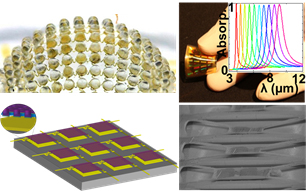Professor Striving to Turn Nanoscale Inventions into Real-Life Products
September 1, 2017

UCF Professor Debashis Chanda
In the very small world of nanoscience, Debashis Chanda, an associate professor at UCF’s NanoScience Technology Center and College of Optics and Photonics, is forging huge innovations in the way we view, use and manipulate light. For instance, Chanda led the development of the world’s first full-color, flexible, skin-like display. The invention consists of plasmonic nanostructures in ultrathin, flexible surfaces that dynamically change colors when applied with different electrical voltage. With the technology being so thin and flexible, a company could produce displays that can assume any shape or form.
During his research, Chanda said he drew inspiration from nature and his childhood fascination with color. Intrigued with the way animals, such as octopuses and chameleons, blend with their surroundings, Chanda looked at ways to create and manipulate color using bendable materials, like thin-film glass, plastic or paper. “That was the beginning. It was new knowledge and a new understanding of the way a nanostructured surface can absorb and reflect sunlight, and how the color is formed.”
Chanda recently took the research further and discovered how to change colors at the subpixel level (red, green, blue or gradations in between) using varying input voltage. Thus, a red subpixel can turn to blue—something not achievable until now. You can read more in the UCF Today article: UCF Research Could Bring ‘Drastically’ Higher Resolution to Your Phone and TV.
With these inventions, the possible applications are wide and varied. Since the inventions enable full-color, high-resolution displays with minimal power, Chanda emphasized their suitability for applications like dynamic e-newspapers and e-readers that function in very bright daylight or roadside billboards that project life-like images and video. Long battery life is essential in such devices, and compared to other technology, Chanda’s inventions greatly extend battery life by only requiring a tiny fraction of power.

A schematic of smart fabrics with integrated sensors that dynamically monitor and display health information.
Additionally, because of their flexibility, the inventions are applicable in wearable technology, such as smartwatches and smart clothing and accessories that can instantly change colors to suit a person’s liking or even monitor and analyze their body metrics. Soldiers could actively change their camouflage as they move through different surroundings. The technology could also be used to produce high-resolution, lightweight eyewear for virtual reality gaming or military simulations.
Both inventions are optioned and undergoing license negotiations by e-Skin Displays, Inc., a California-based company that Chanda co-founded with chief executive officer, Nagendra Nagarajayya.
Over the past 5 years at UCF, Chanda has also made significant advances in developing an ultra-sensitive, multi-spectral infrared detector that may supplant current detectors, since it is portable and does not require expensive cryogenic cooling systems. “Not many detection systems are affordable and efficient,” said Chanda, noting the invention’s benefits. “And [with it] there’s no need to carry a cooling tank.” Chanda explained that high-sensitivity IR detectors, like those at NASA, require cryogenic cooling in order to detect weak infrared radiation. “So you need a big nitrogen tank sitting beside it to cool it down,” he said. Uncooled-type detectors, though portable, fail to provide the detailed, multispectral images that Chanda’s invention offers.

An example of infrared detectors which can detect multi-color infrared photons. Such detectors can be mounted on surfaces of any shape or form.
The Tunable, Uncooled Infrared Detector with Narrow-Band Wavelength Selectivity can detect toxic chemicals in a home as well as a factory. It can also identify elements and substances during space exploration and forensic analysis. In addition, when used in night vision cameras, the new technology could enable people to see in the dark as easily as they do in the day. Users could view images in sharp, clear, multicolored detail, instead of the gray or single-color blurry images found in today’s night vision cameras. For example, the technology could help soldiers move through various terrains at night, and it could be used in cars and other vehicles to help people when driving in the dark.
In terms of future research and commercialization, Chanda wants to keep developing IR detectors and skin-like displays. “I want to solve some of these scientific challenges and improve the performance in the key metrics. I hope to develop low cost, highly sensitive infrared detection and imaging systems.” He also hopes that he and other UCF researchers can get added support through seed funding and a common, shared fabrication facility.
“At the end of the day, we have to fabricate and test our devices,” said Chanda. Yet there is a gap between the academic sample versus an industry-needed prototype. “To make technology mature enough, so that it goes out of the academic lab, you need a little bit of seed funding. The industry wants something on a prototype level; otherwise, everything stays as an academic sample.”
Read more about wearable technology in our patent trending blog. To learn more about Chanda’s research and additional potential licensing or sponsored research opportunities, contact Raju Nagaiah at 407.882.0593.
By: Kathleen Snoeblen